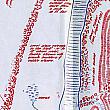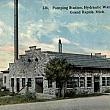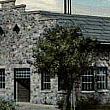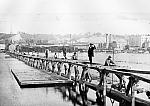
Grand Rapids Water Story, 19th Century, Part II
by Albert Baxter
Abundant Water Sources
By nature this region about the Rapids of Grand River was abundantly supplied with the finest and healthiest of spring water. Except on the west side flats, there were few places where it did not come bubbling and sparkling from the bosom of Mother Earth. All along the bases of the hilly elevations, and well up their sides also, were springs of most excellent water; and on the lower levels it was necessary to dig but a few feet for an ample supply for the households of the early comers. But by nature there was no civilized community here, and hence no natural nor artificial foulness of civilization to defile water sources and courses. In the beginning the white settlers rejoiced over their luxuriant supply, and imagined that it would never prove deficient either in quantity or quality.
The growth to a village and then to a city changed all that. Where at first every family had a fine spring almost at its door, the thickening of the population befouled the water and created the necessity for other and artificial supply. In the infancy of this settlement there was a large spring, from which came a rivulet large enough to run a turning establishment, half way up the hill north of East Bridge street—clear, cool and excellent for domestic use. Just a little southwest from where the Central School building stands, under the brow of the hill, was another, from which a brook ran down Fountain street. In 1848 the latter, and a few years afterward the former, was turned into log pipes for the people “down town,” and both sources are still used in the works of the Grand Rapids Hydraulic Company, though at this day they constitute only a very small portion of its supply. But from this start grew the very comprehensive but not yet perfected system of water works now in use—or rather systems, for there are two; that of the Hydraulic Company being the older, started in 1848, while that of the City Water Works was not fairly established until 1874.
Looking for Additional Sources
In the course of examinations for sources of water supply in the city and adjoining country, the elevations of a considerable number of bodies of water were ascertained, and in 1886 the following statement of them was made by the City Engineer: Reservoir when full, 178 feet; Green Lake, 199; Reeds Lake and Fisk Lake, 141; Church Lake, 167; Saddlebag or Powers Lake, 190; Lamberton Creek (at river), 17; Lamberton Lake, 72.2; Button Lake, 85; Crooked Lake, 114; Hydraulic Well (Penney’s add.), 82.67. The base from which these elevations are calculated is low water at Fulton Street Bridge.
Harnessing the Spring
In the fall of 1848 a number of gentlemen, of whom among the active workers were Canton Smith and Joseph J. Baxter, started the enterprise of supplying the most thickly settled portion of the then village with good spring water for domestic use. For that purpose they took the water from a large spring situated between Ransom and Bostwick streets, a few rods north of Fountain, from which flowed a lively creek down Fountain street. The pipes were the old fashioned pump logs—pine logs of about a foot in diameter, with three inch bore. The boring of the logs was done by Lucius A. Thayer, who fitted an auger especially for that purpose, and operated it by water power in one of the factories above Bridge street between the canal and the river. The pointing and fitting of the logs was done by hand by a ship carpenter. A square curb made of two inch oak plank was sunk at the spring. The trench in which the logs were laid was a ditch, at no point more than three feet in depth. The piping was completed that fall from the spring down Fountain street to Ionia, thence to the National Hotel on Monroe street.
Extending the Service
In the following year the pipes were extended to the foot of Monroe, when it was found that the company had as many customers as that spring would supply. Meantime application was made to the Legislature for an act of incorporation, which was passed April 2, 1849, constituting George Coggeshall, Thompson Sinclair, Charles Shepard, Canton Smith, James M. Nelson, and their successors and assigns, a body corporate, to be known as “The President and Directors of the Grand Rapids Hydraulic Company,” with a capital of not to exceed $30,000. The purpose of the organization was to be (in language of the charter) that of “conducting a plentiful supply of pure wholesome water to said village, and to supply reservoirs for extinguishing fires.” The charter provided that the supply should “be obtained from the springs of water in and about said village, from Coldbrook, from the lake or lakes from which it has its source, or either of them, and from no other source.” This charter was very comprehensive in the powers which it granted to the company, giving the right to enter upon and use streets, lands and springs in and about the village, as might be requisite for its legitimate work, and moreover its franchises were given substantially in perpetuity. This latter point was determined in 1887 through a decision of the Superior Court, affirmed by the State Supreme Court, in a suit wherein the city attempted to restrain and enjoin the Grand Rapids Hydraulic Company from further laying of water pipes within the city. The decree of the courts was in favor of the Hydraulic Company.
Hydraulic Company Charter
The Hydraulic Company’s charter was drawn by Solomon L. Withey, who obtained some valuable hints for its groundwork from the famous charter of the Manhattan Company of New York. Mr. Withey became a member of the company, and its first meeting was held June 20, 1849, at which time its organization was completed by the election of officers. Canton Smith was its first President, and its stock books were opened for subscription June 22, 1849. Having reached the limit of its supply, while the demand was steadily increasing, the Company began to look about for more water. This they obtained from springs a little south of Wealthy Avenue and east of Jefferson, laying logs from that locality to Fulton street, and thence toward the river. They then had a fairly adequate supply for the residents along their lines, and that portion of the then business part of the town west of Division and south of Pearl street. But the city continued to grow, while the springs did not, and more water must be had. The company went still further south and gathered the outflow from several springs on what is called the “Penny eighty.”
Spring Between Bridge and Hastings
About 1854 Christoph Kusterer and John Mangold began the use of the large spring between Bridge and Hastings, a little east of Ottawa street, as a source of water supply for domestic use. Previously, at a very early day, a portion of the stream from that spring had been carried down Bridge street to a watering trough in front of the Bridge Street House, which for years made an excellent watering place for horses. In the summer of 1855 the Council gave permission to the proprietors of the Bridge Street House and Western Hotel, to lay pipes from the spring mentioned for their own use. Kusterer & Mangold, under a franchise obtained in 1859 from the Council, after having constructed a reservoir in which they collected the waters from this and other contiguous springs, laid pump logs down Bridge street and through Kent alley to Lyon street; also to and along by the buildings of the west side of Canal street, as far south as Huron, and down Canal street to near Pearl, giving to the residents thus reached a fair supply of excellent water for domestic use. Neither they nor the Hydraulic Company had sufficient pressure to carry water much above the second floors of buildings even on the lower levels. Only wooden pipes or logs were used until 1857, when upon the first paving of Monroe street, the Hydraulic Company laid a small iron main down that thoroughfare.
Company Expands
In 1864 Amos Roberts, Warren P. Mills, James Lyman and Joseph Penney became stockholders in the Grand Rapids Hydraulic Company. The total stock subscription October 29 of that year was $24,800. In 1870 the water rights of the Kusterer & Mangold company were by mutual arrangement merged in those of the Hydraulic Company. In 1872 the company undertook the construction of a deep reservoir upon ground purchased of Mr. Penney toward the southeastern part of the city, in the hope of greatly increasing its supply. This was a large brick curb with a ca shoe at the bottom, sunk to a depth of about thirty feet. The water from that source is of excellent quality, and though not so abundant in quantity as the company had hoped, it enabled them to largely extend their distribution. Not much addition was made to their water resources until 1886, when they procured a site near the east bank of the river about three-fourths of a mile north of the city, where they sank a reservoir or well, and have established a pumping house station. The well curb is of brick, twenty feet in diameter, and about the same depth, and coated with cement outside and in, so that the inflow is at the bottom. It is fed by spring water from the higher lands adjacent, east, northeast and southeast, where are some find springs and spring brooks. Their pump house is supplied with one compound and one high pressure engine, and two boilers, five feet in diameter and sixteen feet long; four-inch flues, sixty-four in each. Their pumping capacity is estimated at 3,000,000 gallons daily. Warren P. Mills, from 1864 up to the time of his death in 1868, was collector and principal business manager of the company. Since that time Robert I. Shoemaker has been Superintendent of the pipe system.
New Mains and Standpipe
The Grand Rapids Hydraulic Company have not increased, technically, their original capital stock of $30,000, but have issued stock certificates to a large amount, for enlarging and improving their works. Up to the end of 1888 they had laid about fifteen miles of iron mains, from six to twelve inches in diameter, and displaced all but three or four miles of the old wood and small pipes. They have also erected at the corner of Clinton and Newberry streets a stand pipe, 100 feet high and 20 feet in diameter. This is made of steel boiler plate, half an inch thick at the base and a quarter of an inch thick at the top. The officers of the company are, Moses R. Crow, President; John E. More, Vice President and Secretary; David A. Crow, Treasurer; and Robert I Shoemaker; Superintendent.
Robert I. Shoemaker is a native of German Flats, Herkimer County, N. Y., born February 12, 1812. He came to Grand Rapids in April, 1838; was a carpenter and joiner, worked many years at that trade, and has been a busy man all his life. He officiated as bell ringer and as sexton several years in the latter part of the village and early part of the city period. He has seen nearly all there was and is of Grand Rapids, and has not quit work.
Excerpted from History of the City of Grand Rapids, by Albert Baxter, pgs. 206 - 208.
Transcribed by Shirley De Boer

 facebook
facebook











